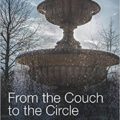Review
Review

Becoming an Effective Art Therapist in the Group Format
A Book Review
Although the existing group art therapy literature focuses on identifying art therapy directives and describing the root of group psychotherapy as being geared toward verbal therapy (Liebmann, 2004; Steinbach, 2014), there has been a gap in the literature when it comes to describing the healing components of art in group work.
The second edition of Bruce Moon’s (2016) text Art-Based Group Therapy Theory and Practice fills this gap. Moon’s focus on art-based group therapy theory and practice is intended for use as a textbook for graduate level art therapy programs, but it is also useful as a supportive resource and source of inspiration for practicing art therapy clinicians.
This book successfully guides the reader on how to use intuition and supports clinical growth through instruction on the use of continuous reflection, learning, and experience in becoming an effective art therapist in the group format. Most importantly, Moon shows how art-based therapy groups help clients, and may be advantageous in treating clients who have not been able to make progress or respond well to traditional talk therapy. Moon’s understanding of group dynamics is influenced by the writings of Corey and Corey (2010) and Yalom (2005); however, the root of his theories lies in art making.
While some similar texts are filled with exercises to use in specific situations, Moon remains a challenging professor, encouraging his students to grow and trust in the transformative process of art-making, which might be constrained by such exercises.
Instead of using a cookbook approach, he describes and encourages ways to increase one’s intuition and discover what works with particular clients and particular groups.
In this well written and easy to follow text, Moon discourages formulaic approaches to group leadership, instead encouraging readers to be open to the process of discovery. In fact, in response to student feedback, Moon moved the chapter on art-based group leadership in this second edition to the beginning of the book to highlight important personality characteristics of art therapy group leaders. These include “a sense of personal power and self-confidence” and serving as artistic role models, demonstrating “a willingness to take both personal and creative risks” (Moon, 2016, p. 15).
He also insists that the group leader constantly work to foster artistic contagion, and describes ways to facilitate a dialogue with group members and their artworks. For example, Moon’s excitement about making art remained strong despite a threatening remark from a new 20-year-old client, mandated to a residential treatment facility by court after being charged with assault. Rather than respond to his threatening and hostile start to the group and falling into an enactment of distancing the group from him, Moon enthusiastically commended this client’s expressiveness and helped him find a way to express his current emotional state by painting a “shit brown” canvas and covering it in jagged lines. Moon was able to honor the client’s feelings and include him in the group, showing him how powerful painting out his anger for all to see could be (pp. 55-60).
The author illustrates group practice that is based in art therapy theory and eloquently describes the powerful and transformative experience of making art with others. Here, Moon describes art therapy basics, such as how art-based groups help clients, and the 13 “therapeutic essentials” (pp. 8-9). For example, “making art in a group setting creates a sense of ritual that provides psychological safety and promotes interpersonal emotional risk-taking”; it also “reduces isolation and creates a sense of community” (p. 8).
Moon raises useful points about the group leader’s struggle to learn artistic and relational self-disclosure, suggesting that art therapists must decide where their styles fall on the continuum by both experiencing “the emptiness of a missed opportunity when they unnecessarily withhold information” as well as “the pain of being hurt by the client who was not ready or able to respond positively to the gift of the group leader’s vulnerability” (p. 17). Therefore, the text is a good primer for novice group psychotherapists practicing with and without artistic elements.
However, Moon’s writing can also feed and inspire the more experienced art therapist. Based on over 40 years of experience running art therapy groups in inpatient hospitals, adolescent residential programs, and graduate art therapy classrooms, Moon’s vivid descriptions are engaging and performative.
Ultimately, this is the greatest strength of the book. While motivating and teaching experienced art therapists about group therapy practice, he is simultaneously demonstrating how to write about the work in a dynamic and beautiful way. His passion for, and trust in, the powerful qualities of art-making shine throughout the text. Moon describes writing the second edition of this text as an “act of love” (p. xvii) and his passion and advocacy for art therapy are contagious.
Most valuably, Moon added a number of new vignettes from clinical and educational settings to bring theories of art therapy to life. He also added chapters exploring ethical issues related to group practice as well as another related to the power of being seen and heard (witnessed) by peers in groups.
There are several poignant examples of patients and students demonstrating resistance to the process of psychotherapy. Moon included an example of a relatively new graduate class of art therapists who were relating to one another superficially, insisting that this was a class and not therapy. He assigned them a group task of covering mural paper with blue and green chalk. In an attempt to move beyond the surface and into the depths, he asked each student to draw and portray themselves as an element or character in this underwater world that represented how they experienced themselves in the group. In discussing the images, the conversation remained light with humor until one woman spoke about the puffer fish she drew and members remarked on its “cuteness.” She quickly reacted, “Well, I may be cute, but you better watch out for those spines. They will hurt you if you get too close” (p. 105). Moon then remarked on how “puffed up” the fish was and the student spoke about how this represented a response to danger, eventually revealing how scared of the class she was because “this ocean felt fake” (p. 105). She went on to insist that the group learn to be real and vulnerable with one another.
Moon’s empathic and open stance, as well as his deep passion and belief in the healing property of art-making, helps clients and students quickly make progress through nonverbal work. Identifying resistance as problems with engaging and connecting, Moon strongly and confidently guides individuals to go deeper into expressing themselves through their art, even if the words are not found. He utilizes all creative expression, including movement, poetry, music, and theater to help clients gain deeper self-understanding. Ultimately, Moon’s descriptions of the process of art psychotherapy are deeply inspiring. He helps art therapists learn to take what they love about creation and art and use it to help others connect and transform themselves in a natural way.
Importantly, Moon argues that art therapy is more effective than is often widely recognized, and may have advantages over verbal therapies. When used in psychotherapy, art can yield transformative mental health outcomes, working to engage resistant clients and students alike. Moon articulates how the unique powers of art and creation can reach clients who cannot easily verbalize their problems. Although Moon describes traditional group therapy theory, he differentiates art-based group therapy theory and highlights advantages to working nonverbally. For instance, art psychotherapy groups are process oriented and engagement in the creative process is the mechanism of change.
The work of art therapy groups differs from that of traditional talk-therapy groups because clients must find a way to engage in the creative process, which can reduce feelings of isolation and foster connection with others by their art being witnessed. This can happen without a verbal discussion.
For example, Moon described an angry 35-year-old on an inpatient psychiatric unit who was loud, offensive, and intimidating. He criticized the art therapy group, questioning what “play(ing) around with crayons” would do for him. One member shared as she checked in that she felt like Sisyphus, a figure of Greek mythology, who was condemned to the repeated meaningless task of pushing a rock up a mountain. Moon assigned the group a task of draw their own version of a metaphorical rock in their lives. The angry client was resistant, but with much encouragement from the entire group, he drew a stormy background with a monolith. Rather than have the group discuss their pieces, Moon had members move their pieces around as if they were in an exhibit. This allowed members to relate to the angry client, and appreciate the sense of the loneliness and pain he was encountering in a safe and non-threatening way.
Over time, this group member created subsequent images symbolizing his “fears, regrets, and inadequacies” (p. 113). He rarely spoke about the images and would retreat into a defensive machismo if the discussion moved from the safety of the imagery toward the feelings they depicted as his own. In maintaining a noncritical and nonjudgmental therapeutic presence, practitioners can utilize the powerful and transformative process of art-making to help clients and students achieve a deeper sense of self-actualization by starting to understand the emotions they often work hard to defend against.
In his epilogue, Moon concludes his text by cautioning and empowering art therapists not to imitate other approaches or professions “in order to be taken seriously” (p. 219). Art therapy is its own unique, legitimate, and powerful profession, and Moon also calls for proper recognition by other professions. He explains this by pointing out the bias in assuming that only talking cures, which he attributes to verbal treatments having a considerably longer history than art therapy. Art therapy may not be as valued within the existing health care hierarchy in part because other disciplines do not fully understand the potential for change through art making.
Although Moon’s text is written for an art therapy audience, it is applicable to all therapists, students, and educators interested in deepening their understanding of the process of psychotherapy. Furthermore, many of the techniques described, such as having a ritual for the beginning and closing of groups or helping members articulate meaningful goals in response to their conflicts, are applicable with patients and students, alike. Moon’s ideas are also helpful for training non-art therapists or talk therapists who want to learn about vulnerability and exposure, which are inherent in the process of making art. Finally, the emphasis on process is applicable across all disciplines. Moon encourages experimentation and learning while reminding readers that psychotherapy is not exclusively about the alleviation of distressing symptoms. Instead, the emphasis here is on helping clients who struggle to verbally identify and express inner states gain a deeper understanding of the self and connection with others. Reading about the powerful impact of art therapy is a useful challenge for other disciplines, as they would certainly benefit from learning how to integrate or translate nonverbal techniques into verbal interventions.
Moon clearly states that this book is tailored primarily as a textbook for graduate students, and ultimately it does seem to reach its full potential when paired with graduate courses and practica. Although inspiring, it may be somewhat difficult for a non-art therapist to know how to integrate nonverbal communication in their groups in a comprehensive way. Although Moon emphasizes that clinicians should learn how to trust their own intuition and inner voice, he does not address some more basic information such as knowing which materials are most clinically appropriate to use for clients. Moon also recognizes in a short chapter towards the end of the book that the art materials he relied on were somewhat limited, as they did not include more current materials of media, photography, video, technology, or found objects (p. 194). A more in-depth explanation of the thought process behind suggesting art materials for clients would improve an otherwise comprehensive book on art-based group therapy. A beginning art therapist may not yet understand the issues of control and vulnerability associated with various materials. In addition, while he presented a number of vignettes with resistant clients, explaining a little more as to why he recommended some materials or including how to handle frustration with materials and the process of art making could add to this. This is something that develops over time and may come more naturally for experienced art therapists who already trust their therapeutic voice. For the sake of therapists early in their careers, it could be helpful to elaborate on these themes.
In conclusion, Moon encourages personal growth in new art therapists as they learn to rely on their intuition and experience exploring their own artwork rather than formulaic interventions. Although he describes therapeutic essentials and characteristics of a group leader more tailored to the novice therapist, Moon’s beautifully written descriptions of group work are inspiring and can help more experienced art therapists find the language to honor their work. Moon argues that artmaking has unique therapeutic qualities that allow art therapy to reach a population of more resistant clients who would not respond well to verbal interventions. This text adds a robust perspective on the transformative theory and practice of art therapy in groups, and will be a source of inspiration and knowledge for therapists, educators, and students focused on psychotherapy.
Cite This Article
Electris, A. C. (2016, December). Becoming an effective art therapist in the group format: A book review [Web article] [Review of the book Art-based group therapy: Theory and practice, by B. L. Moon]. Retrieved from https://societyforpsychotherapy.org/book-review-of-art-based-group-therapy-theory-and-practice/
References
Corey, M., & Corey, G. (2010). Groups: Process and practice (8th ed.). Belmont, CA: Thompson Brooks/Cole.
Liebmann, M. (2004). Art therapy for groups: A handbook of themes and exercises (2nd ed.). New York, NY: Routledge.
Moon, B. L. (2016). Art-based group therapy: Theory and practice (2nd ed.). Springfield, IL: Charles C Thomas.
Steinbach, D. (2014). A practical guide to art therapy groups. New York, NY: Routledge.
Yalom, I. (2005). The theory and practice of group psychotherapy (5th. ed.). New York, NY: Basic Books.





0 Comments